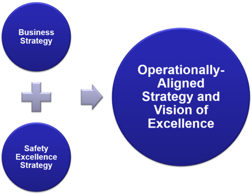Occupational Health & Safety - November 2014
By: Shawn M. Galloway
Printable Version
If culture eats strategy for breakfast, then business strategy eats safety strategy all day long. How well aligned are your business and safety excellence strategy?
Businesses require strategies to capture market share, create shareholder value and provide competitive value for the consumer. Safety, too, competes for market share in the discretionary attention and engagement of the workforce. Safety has both shareholders and customers, and safety excellence is only possible when there is alignment in the belief that safety is less about cost-reduction and more about how it provides competitive value and an improvement in quality of life with the consumers of its efforts.
For years, safety leaders within organizations have attempted to infuse safety thinking into the business. To accomplish this, safety professionals need to infuse business thinking into safety improvement efforts; for as many successful clients have proven, methodologies to accomplish success in safety and business are one in the same.
Businesses create a hypothesis on how, when, where and why they can win in the market place. A business case and value proposition are created for the prospective product or service that outlines the value derived from the offering. Market trends and potential competitors are studied to see how to best position the brand. Pilot launches occur to test the market, and the voice of the customer is collected to shape further decisions. Finally, measurements are established to validate how, when, where and why the business is winning in the marketplace so confidence is created when future results are forecasted.
Chances are your business has a strategy and you are currently deploying some sort of strategic-decision process to shape safety performance and measure its impact. How well aligned are the two strategies? How do they complement or conflict with one another? Do each of the members of the executive team agree with you?

Consider two extremes experienced in very recent consulting engagements. Company A has been on a very aggressive acquisitions campaign over the past five years and further growth through acquisitions remains a strategic priority over the next few years. Company B has experienced a catastrophic disruption to their supply chain, resulting in temporary idling of portions of, or in some locations, the entire workforce.
Company A reacted after several companies were purchased that did not have a safety culture anywhere close to as advanced as the one in the acquiring organization. The safety strategy was, at best, in complete fire-fighting mode, leaving the safety professionals to mop up behind operational decisions. After careful analysis determined how the organization was successfully aligning the operational culture, but not the safety cultures, methodologies were deployed to turn things around. Now Company A is much more proactive, precisely because the safety and business strategies complement, rather than conflict, with one another.
Company B, prior to the impact on their business, was investing significantly in capital expenditures within their locations. New software, programs and training initiatives (many with expensive annual licensing fees) were deployed and starting to make a positive impact on performance. Once the business climate changed, the aggressive safety strategy strangled the business's ability to keep the doors open. Difficult decisions were made that led to a radical consolidation of efforts, and employee-involved choices were made to stop certain safety improvement efforts. Thankfully, Company B is recovering without any decline in safety performance rates. Interestingly, as a result of the strategic framework deployed that directly involved the customers in safety in the turnaround decisions, measurements, observations and story-telling indicate a much stronger and more efficiency-focused safety culture.
In any aspect of business performance, results are required and cultures work with or against the methods to achieve them. As of late, there is a visibly increasing amount of work being done to align cultures with safety objectives to move both hands and feet and hearts and minds. While this is admirable for its advanced thinking, all progress could be distracted, diverted or destroyed should the business strategy change or be misaligned from the start. Strategy is primarily about choices. It's never too late to align the most important business objectives. In fact, those that do are likely to discover it may well become the only sustainable competitive advantage.

Shawn Galloway, CEO of ProAct Safety, is an expert in safety excellence. With almost thirty years of experience, he is a highly sought-after advisor, keynote speaker, and expert witness. Shawn has become a trusted partner to leading organizations across various industries worldwide. He ranks in the top 1% of the most prolific writers in his field, having authored over 500 articles and several bestselling books. He also launched the world's first safety podcast, Safety Culture Excellence©. As a recognized authority in safety, Shawn has received awards such as being named among the Top 50 People Who Most Influence EHS and a Top 10 Speaker, among others.
He is a regular guest on Bloomberg, Fox News, The Daily Mail, Dubai One, U.S. News & World Report, Sirius Business Radio, Wharton Business Daily, and leading safety magazines and podcasts. Shawn also serves as a member of the Harvard Business Review Advisory Council, Forbes Business Council, and Fast Company Executive Board, enabling his influence to shape safety thinking and strategy at the executive level.
